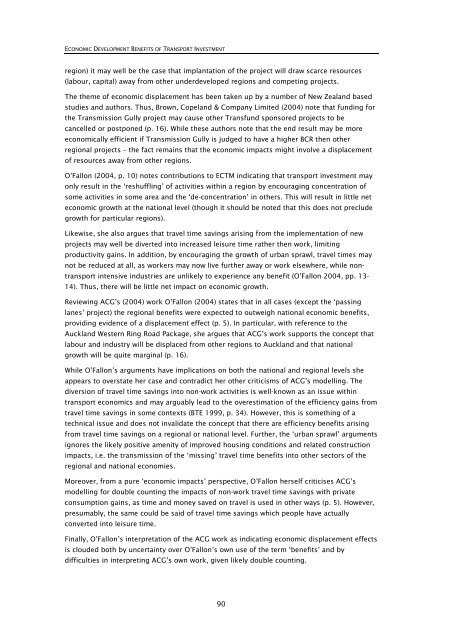Research 350 - NZ Transport Agency
Research 350 - NZ Transport Agency
Research 350 - NZ Transport Agency
Create successful ePaper yourself
Turn your PDF publications into a flip-book with our unique Google optimized e-Paper software.
ECONOMIC DEVELOPMENT BENEFITS OF TRANSPORT INVESTMENT<br />
region) it may well be the case that implantation of the project will draw scarce resources<br />
(labour, capital) away from other underdeveloped regions and competing projects.<br />
The theme of economic displacement has been taken up by a number of New Zealand based<br />
studies and authors. Thus, Brown, Copeland & Company Limited (2004) note that funding for<br />
the Transmission Gully project may cause other Transfund sponsored projects to be<br />
cancelled or postponed (p. 16). While these authors note that the end result may be more<br />
economically efficient if Transmission Gully is judged to have a higher BCR then other<br />
regional projects – the fact remains that the economic impacts might involve a displacement<br />
of resources away from other regions.<br />
O’Fallon (2004, p. 10) notes contributions to ECTM indicating that transport investment may<br />
only result in the ‘reshuffling’ of activities within a region by encouraging concentration of<br />
some activities in some area and the ‘de-concentration’ in others. This will result in little net<br />
economic growth at the national level (though it should be noted that this does not preclude<br />
growth for particular regions).<br />
Likewise, she also argues that travel time savings arising from the implementation of new<br />
projects may well be diverted into increased leisure time rather then work, limiting<br />
productivity gains. In addition, by encouraging the growth of urban sprawl, travel times may<br />
not be reduced at all, as workers may now live further away or work elsewhere, while nontransport<br />
intensive industries are unlikely to experience any benefit (O’Fallon 2004, pp. 13-<br />
14). Thus, there will be little net impact on economic growth.<br />
Reviewing ACG’s (2004) work O’Fallon (2004) states that in all cases (except the ‘passing<br />
lanes’ project) the regional benefits were expected to outweigh national economic benefits,<br />
providing evidence of a displacement effect (p. 5). In particular, with reference to the<br />
Auckland Western Ring Road Package, she argues that ACG’s work supports the concept that<br />
labour and industry will be displaced from other regions to Auckland and that national<br />
growth will be quite marginal (p. 16).<br />
While O’Fallon’s arguments have implications on both the national and regional levels she<br />
appears to overstate her case and contradict her other criticisms of ACG’s modelling. The<br />
diversion of travel time savings into non-work activities is well-known as an issue within<br />
transport economics and may arguably lead to the overestimation of the efficiency gains from<br />
travel time savings in some contexts (BTE 1999, p. 34). However, this is something of a<br />
technical issue and does not invalidate the concept that there are efficiency benefits arising<br />
from travel time savings on a regional or national level. Further, the ‘urban sprawl’ arguments<br />
ignores the likely positive amenity of improved housing conditions and related construction<br />
impacts, i.e. the transmission of the ‘missing’ travel time benefits into other sectors of the<br />
regional and national economies.<br />
Moreover, from a pure ‘economic impacts’ perspective, O’Fallon herself criticises ACG’s<br />
modelling for double counting the impacts of non-work travel time savings with private<br />
consumption gains, as time and money saved on travel is used in other ways (p. 5). However,<br />
presumably, the same could be said of travel time savings which people have actually<br />
converted into leisure time.<br />
Finally, O’Fallon’s interpretation of the ACG work as indicating economic displacement effects<br />
is clouded both by uncertainty over O’Fallon’s own use of the term ‘benefits’ and by<br />
difficulties in interpreting ACG’s own work, given likely double counting.<br />
90
















